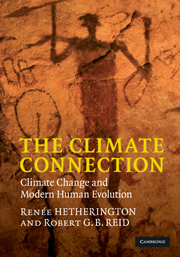Book contents
- Frontmatter
- Contents
- Foreword
- Preface
- Acknowledgements
- 1 Introduction
- Part I Early human history
- Part II Climate during the last glacial cycle
- 5 Climate change over the last 135,000 years
- 6 The effect of 135,000 years of changing climate on the global landscape
- Part III The interaction between climate and humans
- Appendices: The biological background to the story of evolution
- References
- Index
- Plate section
5 - Climate change over the last 135,000 years
Published online by Cambridge University Press: 05 August 2012
- Frontmatter
- Contents
- Foreword
- Preface
- Acknowledgements
- 1 Introduction
- Part I Early human history
- Part II Climate during the last glacial cycle
- 5 Climate change over the last 135,000 years
- 6 The effect of 135,000 years of changing climate on the global landscape
- Part III The interaction between climate and humans
- Appendices: The biological background to the story of evolution
- References
- Index
- Plate section
Summary
Introduction
Current archaeological evidence indicates that modern humans, Homo sapiens, appeared in Africa by 200,000 years ago (McDougall et al., 2005; Shea et al., 2004). Their arrival occurred just prior to a very cold interval known as marine isotope stage 6 (MIS6), when ice sheets expanded across much of Europe, northern North America, and parts of Asia and southern South America. H. sapiens' migration out of Africa occurred during the last glacial cycle (LGC), an oscillating climate interval that saw the Earth move from the warmth of interstadial environments to the extreme cold of the last ice age. The highly variable climate of the LGC was followed by the onset of the relatively warm and stable Holocene period, beginning 11,650 years ago (see Chapter 1, Figure 1.2). About 10,000 years ago, at a number of disparate locations around the world, humans began to ensure a more stable source of food through the development of agriculture and the domestication of animals. The appearance of agriculture and advances in its techniques usually coincided with major climatic changes (see Chapter 8). Since the onset of agriculture we have continued to increase our capacity to manipulate Earth's resources and as a consequence have spawned an exponential increase in global population and consumption. These changes have also begun to seriously impact Earth's climate.
- Type
- Chapter
- Information
- The Climate ConnectionClimate Change and Modern Human Evolution, pp. 141 - 174Publisher: Cambridge University PressPrint publication year: 2010



